| WOOD
Regatta Rock Hall YC * May 20-22, 2011 report by Frank Pedersen ... |
|
WOOD
Boat Regatta at RHYC
A history and review by Frank Pedersen (W8705) Plagiarizing
shamelessly from A
Cruising
Guide to the Maine Coast by Hank and Jan Taft, we learn that
WoodenBoat
magazine was founded on a shoestring in 1974 by Jon Wilson.
Against all odds, including a disastrous
fire, the seductive magazine became the bellwether of a resurgent
interest in
wooden boats. In 1985, it achieved an
astonishing circulation of 100,000, and it has continued to grow.
Its early success is partly attributed to
several contributors: Maynard Bray, a
former curator of Mystic Seaport Museum, Joel White (son of E. B.
White, the
famous writer at The New Yorker and author of such masterpieces
as Charlotte's Web), who owned a boat yard
and was a builder, designer, and skillful writer about yacht design,
and
Benjamin Mendlowitz, a world-class photographer whose work enhanced
articles
about wooden boats.
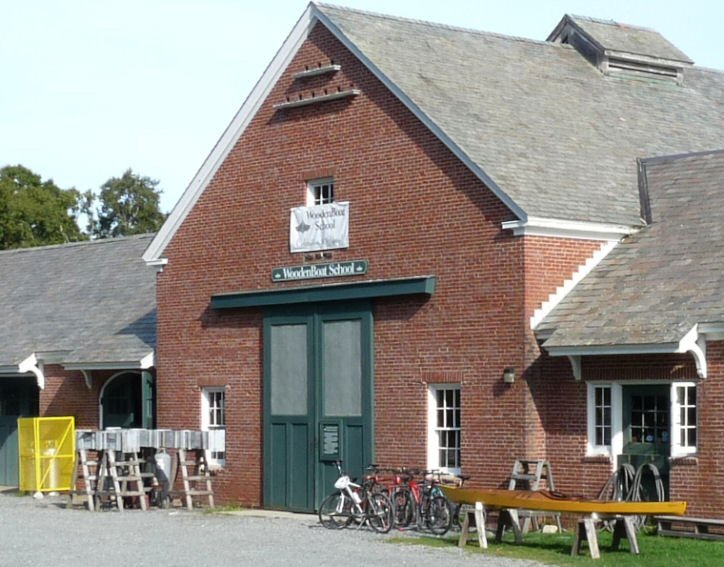 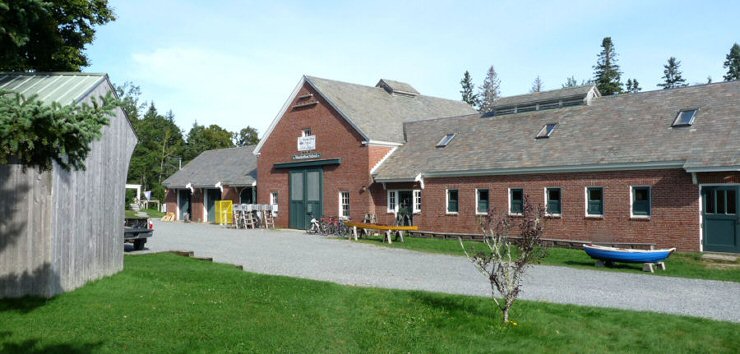 WoodenBoat, housed now in an imposing brick estate along the shore of Eggemoggin Reach in Brooklin, Maine, also has a summer school located in the brick stables of the estate. The school provides short courses in boatbuilding skills of all kinds as well as on-the-water courses in seamanship, navigation, and small-boat sailing. These courses are highly sought after and they often are fully subscribed just a few days after registration opens. In support of the sailing instruction, WoodenBoat owns a fleet of boats used in teaching, which are moored at their waterfront facility. Among the various sailing events WoodenBoat has sponsored, there is the immensely successful Eggemoggin Reach Regatta, a race now in its 25th year, which is open to wooden boats 26ft. and larger. The event is a single race, 16 miles in length, and has attracted fleets of almost a hundred boats racing in 4 or 5 divisions. More recently, the Small Reach Regatta hasbeen held for boats in the 13 ft. to 22 ft. range. Participants in this event are adamantly opposed to formal racing. It is conducted like a Wayfarer Rally over a 5-day period with groups that row or sail to nearby islands for a picnic and the like. (Richard Harrington has attended the Small Reach Regatta one or two times.) Fifty-four boats are registered for this year's event (2011), based out of Lamoine State Park in Maine. WoodenBoat has
moreover
conducted an annual Wooden Boat Show, held in early summer for
builders to display their craft and spectators to admire, covet, and
sometimes
buy them. There is much socializing
among these kindred souls and there also are seminars and lectures on
such
topics as construction, maintenance, design, etc. The sites for
these shows, initially at
least, rotated among areas well known for waterfront activities.
For example:
Newport, Rhode Island, Mystic Seaport in Connecticut, St. Michael's,
Maryland,
and Southwest Harbor, Maine. Racing of
small sailboats emerged hesitantly from these shows, promoted primarily
by WoodenBoat's publisher, Carl Cramer.
The
first WoodenBoat regatta for small boats was sailed in Newport
Rhode Island in
1992 for three designs developed by Joel White:
the Shellback, and the "small" and "large" Nutshells. These boats
were all likely owner-built, many
of which were probably constructed at the WoodenBoat School.
About 20 boats participated. Being
part of the Boat Show,
the regatta was just a single race. By
coincidence, a regatta for 12-meter yachts
was being conducted at the same time. At the
skipper's meeting, it was advised not to hail for rights against the
12-meters.
The
following year, about which only sketchy information is available,
there
apparently was a larger number of one-designs that raced, again at
Newport,
under the Portsmouth handicap system.
Following that, I was told by Carl that the next Boat Show was held at
Southwest Harbor, Maine. Efforts at
holding some racing were not successful.
It appears that the race committee had little experience with small
boats and did not offer an appropriate course. WoodenBoat's
sponsorship of small boat racing languished
after that
experience.
In
more recent years, Carl utilized the possibilities offered by
electronic
communication to stimulate interest in a racing event. WoodenBoat
had developed an internet Forum
that had become immensely popular, and Carl encouraged discussion about
a
dedicated racing event, that is, something more ambitious than a single
race
sandwiched into a boat show. Three ideas
were salient: it was to be held in early
spring, which naturally took the venue out of Maine, or New England
generally;
there would be several races, handicapped under the Portsmouth system;
and new
designs were encouraged in addition to established one-design
classes. The acronym WOOD regatta stands for the Wood
Open and One-Design regatta.
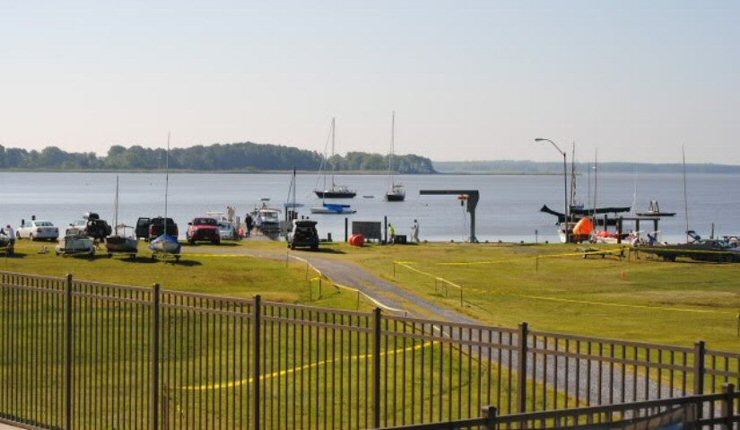 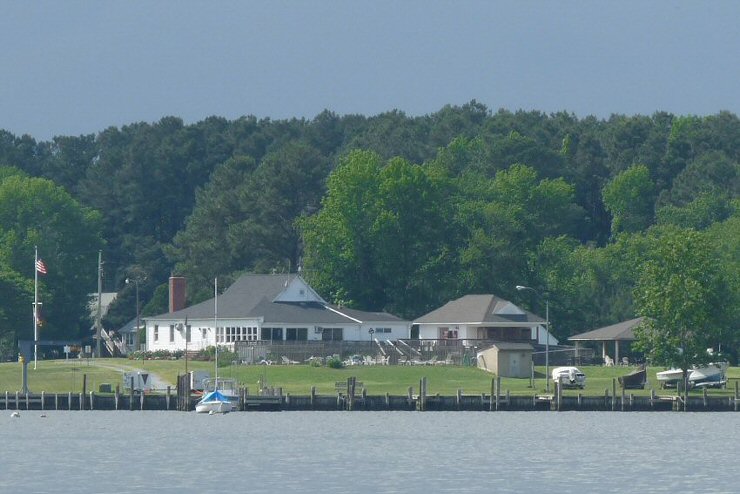 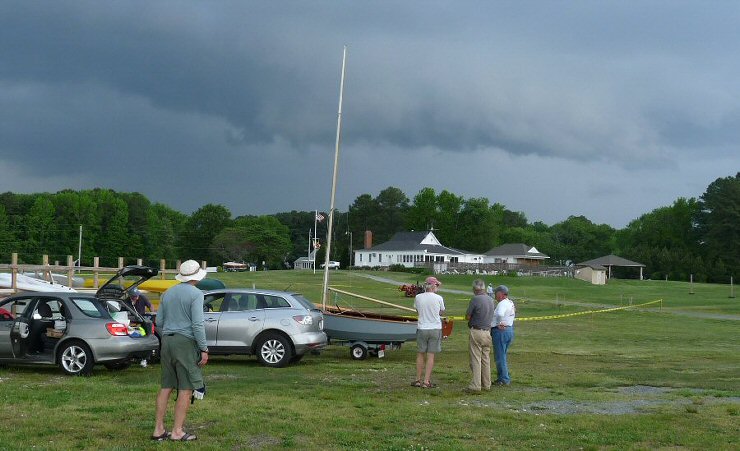 Rock
Hall Yacht Club was selected as the venue for several reasons:
its location promises warm weather and
generally mild sailing conditions; it
has facilities, including electric hoists and a sandy beach, that
allow easy
launching and recovery of boats; it has an experienced race committee,
able to
manage multiple courses and handicap racing; camping is possible; and
it is able to
provide food and beverages for the participants and possible
spectators. There are other reasons as well, but it would
be hard to improve on the site for the purposes intended.
Finally, in the club's long history, wooden
boats have played an important role.
The
WOOD regatta, with racing on May 21 and 22, had approximately
thirty-five
participants, down slightly from earlier expectations. Among the
classes represented were the 110,
Lightning, Fireball, Wayfarer, Hampton, Windmill, Blue Jay, Duster,
Moth, the
Paper Jet, and several one-off designs.
Two courses were sailed, one for smaller boats that included 7 Moths
(Classic only - no foils) that raced as
a separate class, and a second that had two divisions, Performance I
and
Performance II. The Wayfarer (four in
all) raced in Performance II, which included a Windmill, a Hampton (?),
and a
custom 16 ft. cold molded design.
Performance I had a Fireball, three Lightnings, the Turbo model of the
Paper Jet sailed by its designer, Dudly Dix, and the "modified" 110,
the only keel boat in the event.
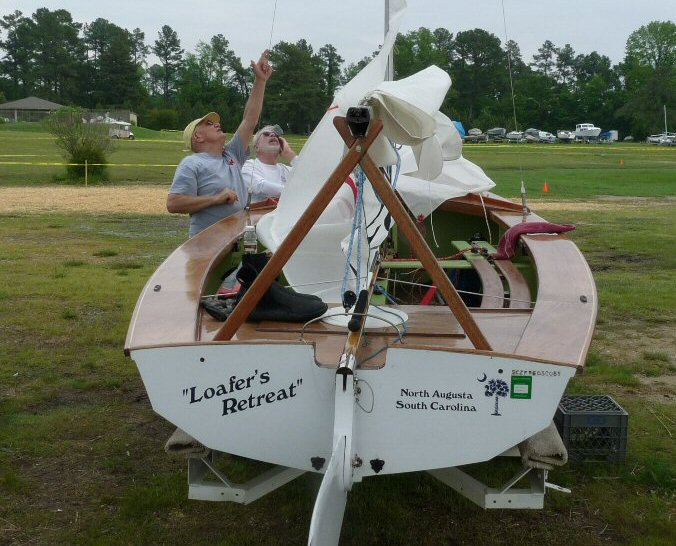 Uncle Al (l) and Jim Cobb discuss Jim's rigging. Wind was generally light to moderate with some variation in both strength and direction. The Wayfarer group had Al Schonborn W3854, Jim Heffernan W1066, Frank Pedersen W8705 and Jim Cobb W7703. All looked outstanding. Al's boat had the longest history of racing. Jim had just completed an extensive rebuild and this was his boat's first time in the water. Frank's boat was sailing only the second time after being completed from a kit in 2010 and some kinks still remained. Jim Cobb's boat also was relatively fresh to the water, the result of a massive rebuild which he completed in a remarkably short time period. He named her Loafer's Retreat, but she might have been named Lazarus, having been literally raised from the dead after years of neglect. Cobb sailed single-handed (he has had experience in the Moth class), which became more difficult when the wind freshened. 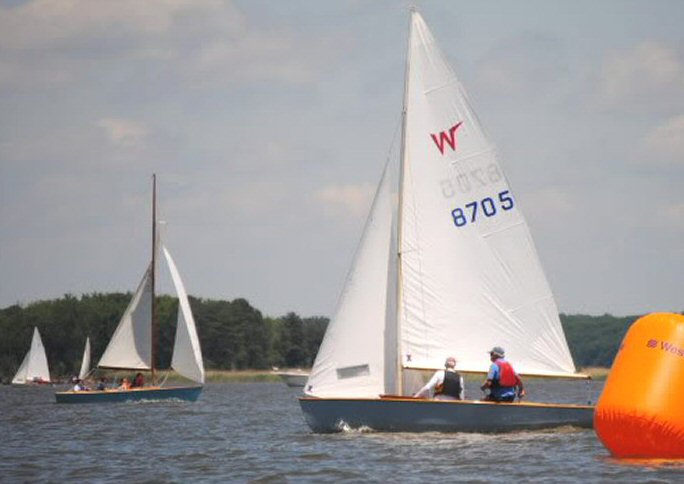 The author, Frank Pedersen (W8705), closes in on the windward mark in one of Sunday's races. 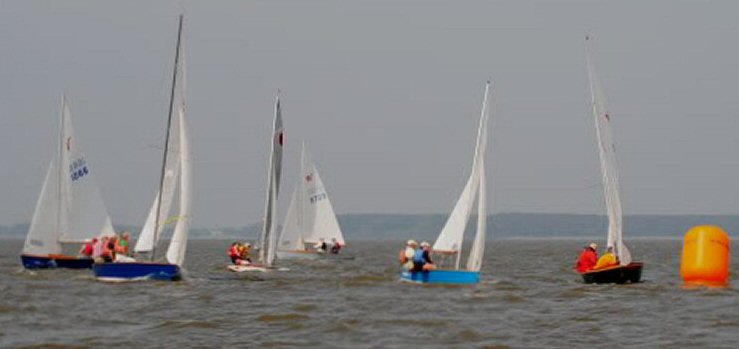 More Sunday windward mark action in the combined Performance I and II fleet (l to r) W1066 Jim Heffernan, Lightning, Fireball, W8705 Frank P., Windmill, W3854 Uncle Al 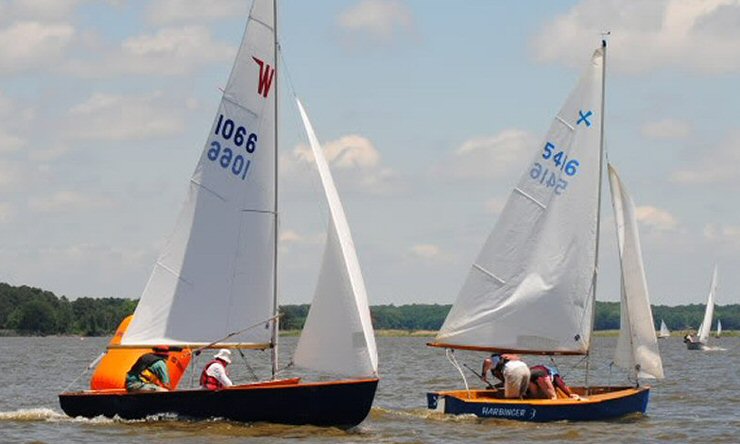 The Windmill leads Jim Heffernan onto the run of a windward-leeward course. As Al Schonborn
observed in a note to Carl Cramer,
participants were generally not "hard core" racers. With 5 races
on Saturday and 3 on Sunday,
several people dropped out as Saturday wore on; in addition, numbers
were
smaller on Sunday. As Al suggested,
Performance I and Performance II were combined on Sunday since the
number racing
had dwindled. Al sailed strongly and
dominated the Wayfarer group even though he was pressed hard by Jim
Heffernan
until rudder damage forced Jim from the competition. Frank was
steady but unremarkable and Jim
Cobb dropped out of several races. The
Windmill provided the only competition from another design, but he was
beaten
soundly by Al on a boat-for-boat basis even thougyh his rating required
giving
time to
the Wayfarer. (Al: Windmills and Wayfarers
should have the same rating, ditto for the Rebels.)
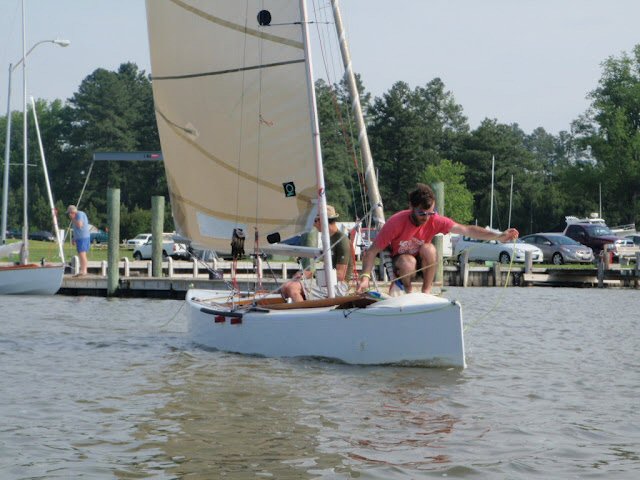 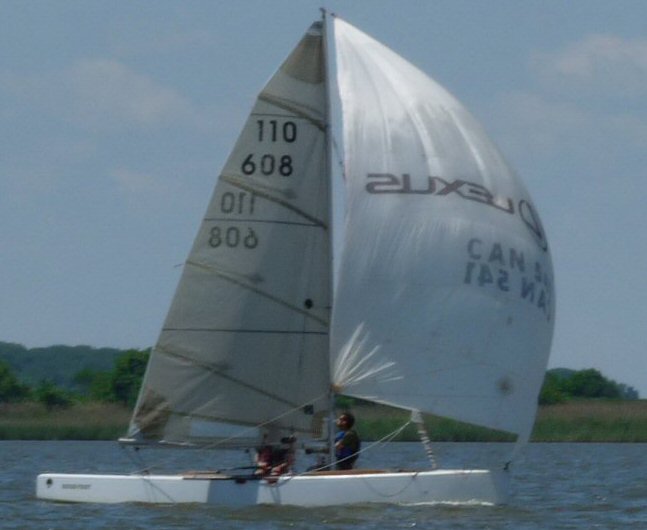 the 110 and the ... 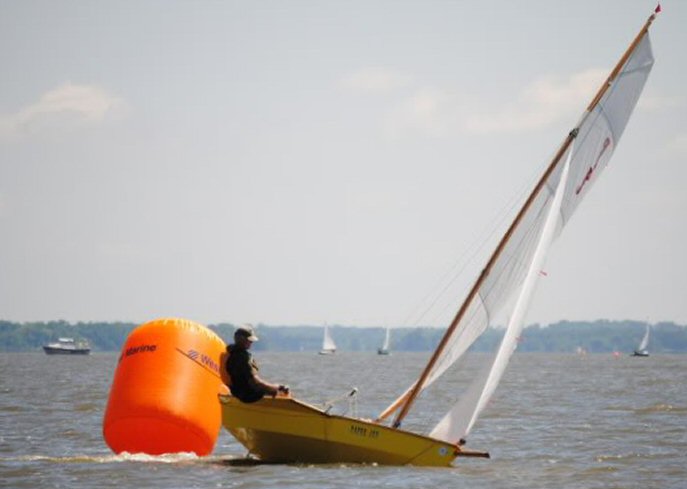 ... difficult Paper Jet 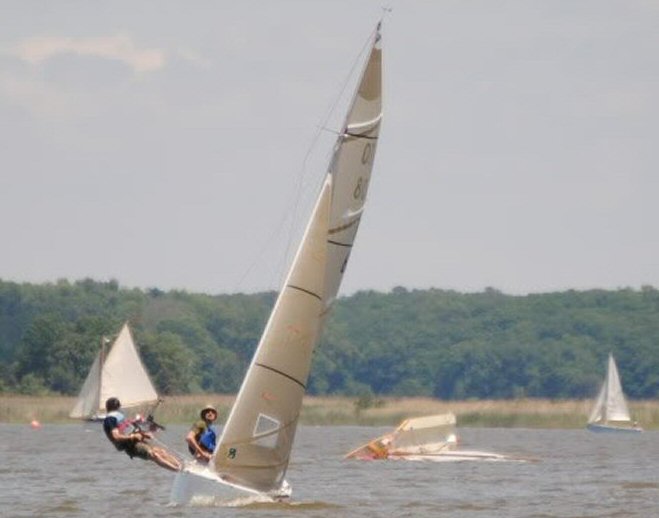 on-rushing 110 plus "side view" of the Paper Jet In Performance I, the souped-up 110 was outstanding. The Paper Jet was disappointing. It was a challenge to manage, even for its designer, with its jib, spinnaker, and trapeze - all on a single-handed boat of near-Laser proportions. One Lightning appeared to be well-sailed, but the others were not up to racing caliber. One charmingly displayed its vintage by sailing with cotton sails. The Moth class, sailing on a separate course with other smaller boats, looked very interesting, but I had no chance to follow their results. Looking back at the
event, my overall reaction
was mixed. On the positive side, the
weather was perfect - at the end of a week marked by severe afternoon
thunderstorms. The venue, Rock Hall
Yacht Club, could not have been improved upon. The Race Committee
did a superb job. Carl was pleased and I understand he plans to
have another WOOD regatta at RHYC again next year.
On the down side, the racing was too demanding for most of the participants. Two races on Saturday and one on Sunday would have been enough. Races could easily have been somewhat longer, however. Come to think of it, back in the 1960's, when we all sailed wooden boats, three races was a typical regatta. With a lighter racing schedule, more on-shore activities might have been included. Spectators might have had more time to talk with boat owners (and, in some cases, builders), and racers might have gotten to know one another and a greater variety of boats than are commonly found at a regatta. The goal of comparing
different designs in
actual racing conditions was somewhat defeated by dividing the faster
boats
into two divisions. If they had all
sailed together, the results could have been sorted out with the
handicap
system, but there would have been a more solid basis to get a real
sense of
just how they performed. In this way,
the regatta might have had some of Yachting
Magazine's
One-Of-A-Kind races' characterwhen these
were held in the 1960's and 1970's.
On balance, I think it was a worthwhile showcase for the Wayfarer class. In other classes, wooden boats often sail as a separate "classic" division, perhaps because fiberglass hulls have been optimized within the measurement tolerances and they may outperform the wooden boats. In the Wayfarer class, we are confident that wooden hulls compete equally to fiberglass ones - and they look prettier, too! |